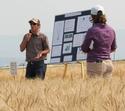Associate CE Specialist
Department of Plant SciencesPlant and Environmental Sciences Bldg.
One Shields Ave
Davis, CA 95616
530-902-7295
melundy@ucdavis.edu
Links
- Grain Cropping Systems Laboratory
- Small Grains Research and Information Center
- UC Davis Department of Plant Sciences
Biography
Mark received his MS in International Agricultural Development and his PhD in agronomy at UC Davis. He has worked as an agronomist for the University of California since 2013, first as a UCCE Agronomy Advisor, and more recently as Associate Professor of Cooperative Extension and CE Specialist in Grain Cropping Systems at UC Davis. His work strives to solve practical problems, produce outcomes that inform both production and environmental concerns, and communicate these outcomes in farmer-accessible formats as well as to the broader scientific community.
Education
Ph.D. Agronomy, University of California, Davis. 2013
M.S. International Agricultural Development, University of California, Davis. 2010
B.A. English, University of Arizona. 2002
Discipline
AgronomySpecialty
Grain Cropping Systems, resource use efficiency, integrating technology into production practices, nitrogen and carbon cycling in crop-soil systems, genotype x environment x management interactions, phenotyping, remote/proximal sensing technologiesAreas of Expertise (click to see all ANR academics with this expertise)
- Field Crops - General
- Forage Crops - General
- Grains
- Grains - General
- Barley
- Corn, Field
- Wheat
- Plants and Their Systems
- Plant Management Systems
- Integrated Pest Management Systems
- Water
- Conservation and Efficient Use of Water
- Watershed Protection and Management
- Soil
- Soil, Plant, Water, Nutrient Relationships
- Weather and Climate
- Pollution Prevention and Mitigation
- Engineering Systems and Equipment
- Waste Disposal, Recycling, and Reuse
- Instrumentation and Control Systems
- Geographic Information Systems
- Nutrients and Water in Agricultural Landscapes
- Water Quality, Quantity, and Security
- Sustainable Food Systems
Bibliography
Peer Reviewed
- Ramanan, M.; Nelsen, T., et al. (2023). Effects of Genotype and Environment on Productivity and Quality in Californian Malting Barley. Agronomy Journal 115: 2544-2557. https://doi.org/10.1002/agj2.21433
- Taylor, K. M.; Nelsen, T. S., et al. (2023). No-till annual wheat increases plant productivity, soil microbial biomass, and soil carbon stabilization relative to intermediate wheatgrass in a Mediterranean climate. Soil and Tillage Research, 235: 105874. https://doi.org/10.1016/j.still.2023.105874
- Rehman, T.H.; Lundy, M.E., et al. (2023). Reflectance Measurements from Aerial and Proximal Sensors Provide Similar Precision in Predicting the Rice Yield Response to Mid-Season N Applications. Sensors 2023, 23(13), 6218. https://doi.org/10.3390/s23136218
- Taylor, K.; Samaddar, S., et al. (2023). Soil carbon storage and compositional responses of soil microbial communities under perennial grain IWG vs. annual wheat. Soil Biology and Biochemistry, 184, 109111. https://doi.org/10.1016/j.soilbio.2023.109111
- Peterson, C.A.; Pittelkow, C.M., et al. (2023). Targeted irrigation expands scope for winter cereal production in water-limited areas of California's San Joaquin Valley. Agricultural Systems, 210: 103696. https://doi.org/10.1016/j.agsy.2023.103696
- Rehman, T.; Lundy, M., et al. (2022). Comparative sensitivity of vegetative indices measured via proximal and aerial sensors for assessing N status and grain yield in rice cropping systems. Remote Sens. 14(12), 2770. https://doi.org/10.3390/rs14122770
- Peterson, C.; Pittelkow, C., et al. (2022). Exploring the potential for water-limited agriculture in the San Joaquin Valley. Public Policy Institute of California, Report, July 2022. https://www.ppic.org/publication/exploring-the-potential-for-water-limited-agriculture-in-the-san-joaquin-valley/
- Nelsen, T.S; Rodriguez, M., et al. (2022). Improvements to the Soil Nitrate Quick Test for California Small Grains. California Agriculture 76(2):93-99. https://doi.org/10.3733/ca.2022a0009
- Tamagno, S.; Pittelkow, C., et al. (2022). Optimizing water and nitrogen productivity of wheat and triticale across diverse production environments to improve the sustainability of baked products. Front. Plant Sci. 13:952303. https://doi.org/10.3389/fpls.2022.952303
- Tamagno, S.; Eagle, A., et al. (2022). Predicting nitrate leaching loss in temperate rainfed cereal crops: relative importance of management and environmental drivers. Environ. Res. Lett. 17:6. https://doi.org/10.1088/1748-9326/ac70ee
- Kanter, J.; Clark, N., et al. (2021). Top management challenges and concerns for agronomic crop production in California: Identifying critical issues for extension through needs assessment. Agronomy Journal: 113: 5254–5270. https://doi.org/10.1002/agj2.20897
- Nelsen, T.; and Lundy, M.E. (2020). Canopy reflectance informs in-season malting barley nitrogen management: An ex-ante classification approach. Agronomy Journal. https://doi.org/10.1002/agj2.20397
- Becker, T.; Nelsen, T.S., et al. (2020). Differentiating between Nitrogen and Water Deficiency in Irrigated Maize Using a UAV-Based Multi-Spectral Camera. Agronomy. 10(11):1671. https://doi.org/10.3390/agronomy10111671
- George, N.; and Lundy, M.E (2019). Quantifying Genotype x Environment Effects in Long-Term Common Wheat Yield Trials from an Agroecologically Diverse Production Region. Crop Sci. 59, 960-1972.
- Carrijo, D.R.; Lundy, M.E., et al. (2017). Rice yields and water use under alternative wetting and drying irrigation: A meta-analysis. Field Crops Research. 203, 173-180.
- Lundy, M. E.; Parrella, M.P. (2015). "Crickets Are Not a Free Lunch: Protein Capture from Scalable Organic Side-Streams via High-Density Populations of Acheta domesticus." PLOS ONE
- Lundy, M.E.; Pittelkow, C.M., et al. (2015). "Nitrogen fertilization reduces yield declines following no-till adoption." Field Crops Research 183: 204-210.
- Pittelkow, C.M.; Linquist, B.A., et al. (2015). "When does no-till yield more? A global meta-analysis." Field Crops Research 183: 156-168.
- Pittelkow, C. M.; Liang, X. Q., et al. (2014). "Productivity limits and potentials of the principles of conservation agriculture." Nature
- Lundy, M. E.; Hill, J. E., et al. (2014). "Site-specific, real-time temperatures improve the accuracy of weed emergence predictions in direct-seeded rice systems." Agricultural Systems 123: 12-21.
- Liang, X. Q.; Li, L., et al. (2013). "Dissolved phosphorus losses by lateral seepage from swine manure amendments for organic rice production." Soil Science Society of America Journal 77: 765-773.
- Lundy, M. E.; Spencer, D.F., et al. (2012). "Managing phosphorus fertilizer to reduce algae, maintain water quality, and sustain yields in water-seeded rice." Field Crops Research 131: 81-87.
- Lundy, M. E.; Fischer, A.J., et al. (2010). "Surface applied calcium phosphate stimulates weed growth in flooded rice." Weed Technology 24: 295-302.
ANR Workgroup Associations
- Small Grain - Chair
- Alfalfa and Forage Systems - Member
- Dairy Quality Assurance - Member
- Vegetable Crops - Member
- Weed - Member

